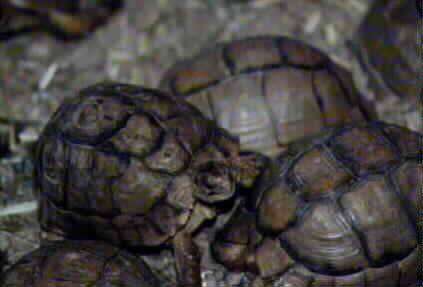
|
Tortoises

|
In the wild these tortoises inhabit the very hot, arid zones feeding on many
sorts of vegetative matter. They rarely encounter water in the wild, however,
in captivity, they exhibit their great love for bathing if you introduce a
shallow pan of water. The animals will enter the pan and ‘soak’ for hours,
apparently enjoying the treat.
They are voracious eaters if the temperature is kept within their required
range of 80 to 95 degrees. We feed ours a salad of mixed greens (most lettuces
excluding iceberg, especially kale, endive, romaine, etc. We also offer finely
chopped carrots, sweet potatoes and broccoli, squash, green beans, etc. as
well as canned whole kernel corn and rehydrated dried lentils and certain
beans. They can be given certain non-toxic flowers such as rose, hibiscus,
bergamot petals, borage, chives, cress, dill, fennel, lavender, thyme, mints
(excluding pennyroyal), oregano, sage, rosemary, safflower, sweet cicely,
calendula, carnation, pansy, marigold, and nasturtiums. I recommend that you
only give petals because some stems and calyx could be toxic. There are probably
many native flowers that could be given to these tortoises, however, check
with your county agriculture extension agent BEFORE introducing any to the
tortoise’s diet.
When you prepare their meal be certain that all vegetables and flowers are
free of pesticides and fertilizers which can be harmful to them.
We have a large breeding group of Kleinmanni in a ‘tortoise corral’
in our basement. The floor is concrete over which we have laid heavy plastic.
We use rabbit pellets as the substrate. Sand is not a good idea because they
can ingest it with their moist food and can become impacted with subsequent
death.
The tortoises have no odor of their own and the only thing we smell is the
rabbit pellets. They excrete a hard dry pellet and a small amount of inoffensive
urine.
Our tortoises are very friendly. We have NEVER encountered an aggressive animal
to date. They all come to the sound of "Dinner’s Ready". It is really
cute to watch them stampede at a tortoise’s rate of speed to the dinner plate.
We use cookie sheets for the chopped vegetables, and whole heads of lettuce
are placed at random on the substrate. Often, I sit in the corral and watch
them. And when I am feeling blue these little angels beg for my attention
by crawling into my lap, or nibbling at my toes. Just to watch them go about
their lives, carrying their homes with them, asking so little of me makes
me feel very, very humble and at peace.
At this time, the Kleinmanni’s are Appendix I on CITES and can no longer
be imported and the Graeca are Appendix II.
Parasites can be detected by means of fecal flotation. Panacur (fenbendazole)
is often. You will have to see what strength your fenbendazole is. Usually
hree treatments are required at 2 week intervals. Never, Never use Ivermectrin
in any tortoise!!!!! Giving the medication is tricky as the tortoise will
pull in its head when it wants to escape. You can easily mix it with their
food however.
Imagine a tortoise corral in your den decorated with a few rocks and attractive
plants and a group of Klenimanni roaming around. These very primitive
little dolls can learn, and will recognize the sound of your
footsteps, the clank of the food pan and their name.
They eat plant materials such as vegetables , fruit and new shoots as well
as some worms, snails and even carrion. Their scientific name is Testudo carbonaria.
They are often up to 50cm across the shell from head to tail.
The animals will enter any available water and ‘soak’ for hours, apparently
enjoying the treat.
When you prepare their meal be certain that all vegetables and flowers are
free of pesticides and fertilizers which can be harmful to them.
The tortoises have no noticeable odor of their own. They excrete a hard dry
pellet and a small amount of inoffensive urine.
Our tortoises are very friendly. We have NEVER encountered an aggressive animal
to date. They all come to the sound of "Dinner’s Ready".
Parasites can be detected by means of fecal flotation. Panacur (fenbendazole)
is often used. You will have to see what strength your fenbendazole is. Often
hree treatments are required at 2 week intervals. Never, Never use Ivermectrin
in any tortoise!!!!! Giving the medication is tricky as the tortoise will
pull in its head when it wants to escape. You can easily mix it with their
food however.